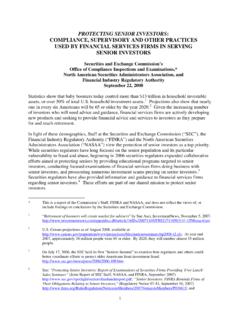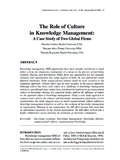Transcription of 2016 Law Firms in Transition - Altman Weil
1 2016 Law Firms in Transition An Altman Weil Flash Survey [This page is intentionally blank.] 2016 Law Firms in Transition An Altman Weil Flash Survey Contributing Authors Eric A. Seeger Thomas S. Clay Copyright 2016 Altman Weil, Inc. All rights reserved. No part of this work may be reproduced or copied in any form or by any means without prior written permission of Altman Weil, Inc. For reprint permission, contact Altman Weil, Inc. 3748 West Chester Pike, Suite 203, Newtown Square, PA 19073 or 2016 LAW Firms IN Transition An Altman Weil Flash Survey Table of Contents Introduction .. i Market Forces .. 1 Leading Change .. 13 Lawyer Staffing Strategies .. 26 Law firm Headcount & Growth .. 42 Efficiency of Legal Service Delivery.
2 59 Pricing Strategies .. 65 Financial Performance .. 78 Bonus 89 Participant Demographics .. 91 [This page is intentionally blank.] 2016 LAW Firms IN Transition An Altman Weil Flash Survey i LAW Firms IN Transition 2016 Are law Firms still in Transition in 2016? We think so, although the pace of change can seem modest. Despite pockets of true innovation, most Firms are choosing to proceed with lawyerly caution in the midst of a market that is being reinvented around them. Now in its eighth year, Altman Weil s Law Firms in Transition Survey continues to document market forces that are reshaping the competitive legal landscape, identify ways in which law Firms have responded (or are lagging in their response), and prescribe how law firm leaders can find competitive advantages in a redefined marketplace. Key findings from the 2016 survey include: Unreliable demand: Market demand for legal services has failed to return to pre-recession levels in a majority of US law Firms .
3 Many firm leaders remain concerned about how to grow profitability in a market characterized by stagnant or declining demand, intense competition from old and new sources, commoditization, and price pressures. Surplus of lawyers: Broad overcapacity is creating an ongoing drag on law firm profitability. Overcapacity and underutilization are prevalent among equity and non-equity partners, especially in larger Firms . Compensation adjustments are being used in most Firms to deal with underperforming partners, and chronic underperformers are being counseled out of their Firms . Inefficient delivery of legal services: Although nearly all Firms identified the need to improve the efficiency of legal service delivery as a permanent trend, more than half have not significantly changed their approach to achieve greater efficiencies. Proactivity as a competitive advantage: We see a 7-year trend of compelling success enjoyed by Firms that take a proactive approach to alternative fee arrangements.
4 We think this is a good indicator that proactive change in other areas could be equally effective in accelerating law firm performance relative to competitors. 2016 LAW Firms IN Transition An Altman Weil Flash Survey ii Resistance to change: The pace of external change being experienced by law Firms is not expected to slow in the foreseeable future. The slower pace of internal change in many Firms is attributable not to lack of awareness or will among law firm leaders but to low awareness and high resistance among their partners. Financial Performance and Outlook Just over two-thirds of law Firms reported gross revenue and revenue per lawyer increases in 2015. Profits per equity partner (PPP) were up in 65% of Firms . Twenty-three percent of Firms saw PPP decrease in 2015 and almost half of those Firms were down sharply (4 percent or more). Many firm leaders are not optimistic about the ability to maintain an upward trajectory on profitability.
5 Nearly half (47%) of leaders believe a slowdown in profit per partner growth is a permanent trend in the profession. Law Firms financial trajectories are no longer consistent or guaranteed. We know a significant number of Firms move in and out of the plus column from year to year, buffeted by a variety of market forces. We also know that a drop in profitability numbers, especially in consecutive years, can trigger key partner departures and create immediate vulnerabilities. Demand Only 38% of law firm leaders say demand for services has returned to pre-recession levels in their Firms . Another expect demand to return in 2016 or 2017, leaving nearly half of all Firms that think pre-recession demand is at least three to five years away if it returns at all. Most firm leaders (62%) think the erosion of overall demand for work done by law Firms is a permanent trend. A combination of market forces have combined to put pressure on law Firms traditional flow of work from clients, including more price competition, seen as a permanent trend by 95% of law firm leaders, commoditization of legal work (88%), replacement of human resources by technology (85%), and competition from non-traditional service providers (82%).
6 2016 LAW Firms IN Transition An Altman Weil Flash Survey iii The most immediate threat is coming from law Firms own clients. Sixty-eight percent of Firms report they have already lost business to corporate law departments in-sourcing more work, and another 24% perceive this phenomenon as a potential threat. Clients use of technology that reduces the need for lawyers and paralegals is considered a current threat in 21% of Firms and a possible future threat in another 53% of law Firms . Larger Firms were much more likely to be affected by these competitive threats than smaller Firms . Individual law Firms may or may not be in Transition , but clearly the market is changing around them. Firms are faced with an evolving competitive landscape and shrinking or shifting demand. Any firm that is not actively planning to meet these challenges ignores them at its peril. Lawyer Staffing, Overcapacity and Growth Firms are having trouble keeping their lawyers utilized, with half of all Firms (52%) reporting their equity partners are not sufficiently busy.
7 Overcapacity and underutilization are worst among non-equity partners: 62% of Firms report their non-equities are not sufficiently busy, including 80% of Firms with 250 or more lawyers. Widespread overcapacity is holding down profitability in 60% of all Firms and in 76% of larger Firms . Law firm leaders are split on the strategic value of growth only 53% of them said growth in lawyer headcount is required for their firm s success, and 60% see fewer equity partners as a permanent trend. Only half of all Firms expect to have more equity partners five years from now than they have today. Law Firms are trying to address these issues in a number of ways. Lateral acquisitions are seen as quick way to buy market share in a low-growth environment, and 85% of law Firms report they added lawyers last year who brought new business to the firm . However, 47% of Firms lost lawyers who left and took business with them in the same time period. A majority of Firms are practicing basic labor arbitrage shifting work to less costly lawyers.
8 More than half of all law Firms are utilizing part-time lawyers (59%) and 2016 LAW Firms IN Transition An Altman Weil Flash Survey iv contract lawyers (56%) to meet demand as needed. Three quarters of Firms with 250 or more lawyers are using part-time and contract lawyers. Only 9% of Firms are currently outsourcing legal work, but 52% of firm leaders believe that is a permanent trend in the profession. The most obvious solution to the overcapacity problem is to cut underperformers. Fifty-four percent of Firms report that they dropped lawyers who didn t have enough work in 2015, and 73% of Firms are removing chronically underperforming partners. Almost half of Firms (48%) are taking the interim step of de-equitizing full partners, moving them out of the profit-sharing class. Law Firms are acutely aware of their own staffing imbalances and are making efforts to address them, but in too many Firms personal, political and cultural obstacles are hindering pragmatic economic decisions.
9 Non-equity partners present the most obvious target for law firm right-sizing, as that class has been allowed to grow larger than current economics and likely future demand can justify. Law Firms simply cannot maximize their effectiveness until they deal with the issue of overcapacity head-on. Efficiency and Pricing Despite the fact that 93% of law firm leaders think a focus on improved practice efficiency is a permanent trend in the legal market, fewer than half of all law Firms (44%) have significantly changed their strategic approach to efficiency seemingly a large strategic disconnect. The only efficiency tactics that break the 50% mark among all law Firms are knowledge management (54%) and use of technology tools to replace some human resources (52%). Techniques that really challenge the way work has been done traditionally, like legal project management or reengineering of work processes, are less likely to have been adopted, especially in smaller Firms .
10 Only one third of law Firms are making strategic changes in their approach to pricing a number that has remained basically unchanged since we started asking the question in 2013. There s a stark distinction between Firms with 250 or more lawyers 2016 LAW Firms IN Transition An Altman Weil Flash Survey v and smaller Firms here. Fifty-seven percent of larger Firms are making strategic changes in pricing approach, while only 26% of smaller Firms are doing so. The one pricing tactic that has been adopted by a majority of large and small Firms is developing data on the cost of services sold. Sixty-seven percent of all Firms and 91% of large Firms are doing this fundamental analysis, which should enable them to structure more customized fee proposals. Sixty-four percent of large Firms have added a Pricing Director or staff equivalent, compared to only 12% of smaller Firms . Discounts the least strategic approach to pricing change are widespread.











